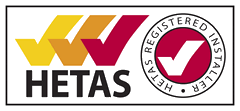Flue Liners & Cowls
Houses built since 1965 have chimneys built with liners during their construction. This was usually done with a clay liner which should last the life time of the building, although may do not due to poor installation standards. Prior to 1965 lining was less common and chimneys were instead rendered with a lime mortar.
Most old chimneys need to be relined before they can be re-used, particularly those that were built without a lining or have a flue that is too big and inefficient for modern stoves and fires. After years of use an old chimney can suffer attack from heat and soot deposits that erode mortar joints. This can cause many problems, such as staining and also leakage of dangerous fumes into the home. Installing a new liner that provides a new sealed and correctly sized flue can dramatically improve the efficiency and safety of an old chimney
There are several methods of doing this suitable for a solid fuel appliances which include:
Installing rigid sections of clay, refractory concrete, ceramic or pumice into the chimney by cutting into the flue wall or by lowering down from the top.
Pumped refractory concrete around an inflatable former by a specialist contractor.
Rigid metal liners made from high grade stainless steel pipes lowered from the top.
Flexible metal liner in continuous length either lowered down or pulled up the flue.
Spray on coating by a specialist contractor.
Generally, for solid fuel and wood burning the space around the new lining should be filled with an insulating material such as Perlite, Vermiculite or Leca. Better still, the lining material itself should have a high insulation value i.e. liners made with pumice.
Flue outlets must be above the roof line to effect clear, unhindered dispersal of combustion products without creating a fire hazard. The direction of the flue should be should be straight and vertical where possible. Horizontal runs should be avoided and in any event must not exceed 150 cm in length. Bends should not exceed 45º to the vertical to maintain natural draft and ease of cleaning. There should be no more than two bends in a flue. Only one appliance may enter any flue and all flues should be insulated to prevent condensation of water/tar and to protect the building against the effects of chimney fires.


